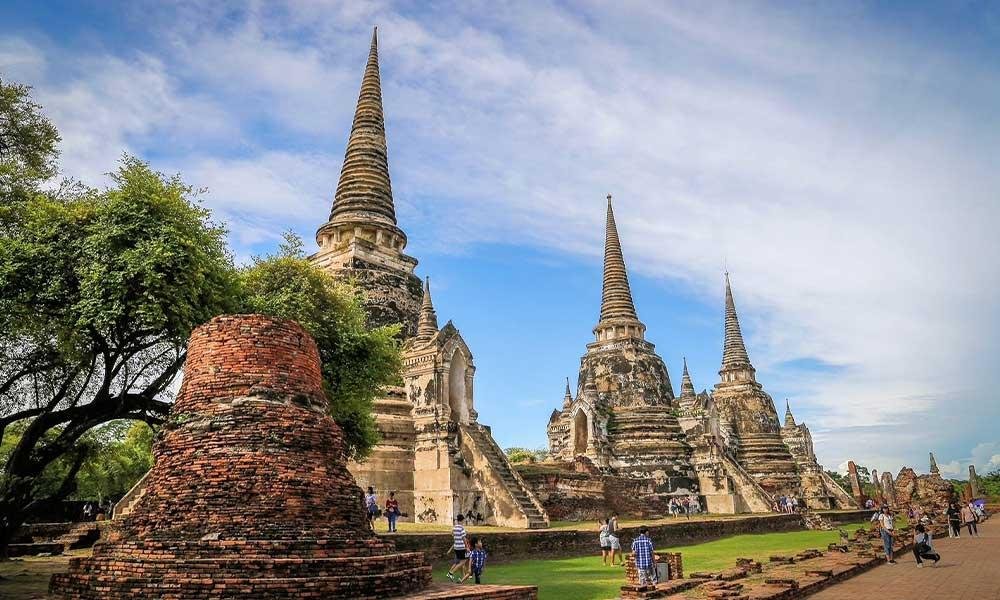Ayutthaya - Nestled along the banks of the Chao Phraya River, Ayutthaya stands as a testament to Thailand's rich cultural and historical legacy. The ancient city, once the capital of the Kingdom of Ayutthaya, was a flourishing center of trade, culture, and power for over four centuries. In this blog post, we will embark on a journey through time to unravel the captivating history of Ayutthaya, exploring the rise, splendor, and eventual decline of this majestic city.
- The Glorious Rise: Foundation and Early Years
Founded in 1350 by King U Thong, Ayutthaya swiftly rose to prominence, establishing itself as a dominant force in Southeast Asia. The city's strategic location along the Chao Phraya River facilitated trade and cultural exchange with neighboring regions. Ayutthaya became a melting pot of diverse influences, blending Thai, Khmer, and Mon cultures to create a unique and vibrant society.
The city's grandeur reached its zenith during the reign of King Narai the Great in the 17th century. Ayutthaya evolved into a cosmopolitan capital, welcoming diplomats, traders, and artists from Europe, Japan, China, and other parts of the world. Its wealth and cultural richness earned Ayutthaya the title of "Venice of the East."
- Cultural Flourish: Art, Architecture, and Religion
Ayutthaya's golden era witnessed an unprecedented flourishing of art and architecture. Magnificent temples, palaces, and sculptures adorned the landscape, showcasing the kingdom's cultural and religious diversity. The Wat Phra Si Sanphet, with its iconic three chedis, and the Wat Mahathat, known for the Buddha head entwined in tree roots, stand as enduring symbols of Ayutthaya's artistic prowess.
The city embraced Theravada Buddhism, and monastic life thrived. Ayutthaya became a center for Buddhist learning, attracting scholars and monks from various regions. The influence of Ayutthaya's cultural and religious achievements extended beyond its borders, leaving an indelible mark on the broader Southeast Asian region.
- Dramatic Decline: Wars and the Fall of Ayutthaya
Despite its golden age, Ayutthaya faced external threats from neighboring powers. The Burmese invasion in 1767 marked a tragic chapter in Ayutthaya's history. The invaders razed the city, reducing its once-majestic structures to ruins. The fall of Ayutthaya led to the capital's relocation to Thonburi and, eventually, to Bangkok under the Chakri Dynasty.
- Preserving the Legacy: Ayutthaya Today
Today, Ayutthaya stands as an archaeological wonder, designated as a UNESCO World Heritage Site. Visitors can wander through the historic park, exploring the remnants of temples and palaces that whisper tales of a bygone era. The Ayutthaya Historical Study Center and various museums in the city provide a deeper understanding of Ayutthaya's rich history and cultural significance.
Conclusion:
Ayutthaya's history is a captivating narrative of rise, grandeur, and eventual decline. The remnants of this once-mighty kingdom continue to inspire awe and admiration, reminding us of the resilience of cultures and the enduring legacy of civilizations. As we walk through the ancient ruins and explore the historical sites, we connect with a chapter of Thailand's past that shaped the nation's identity and contributed to the cultural tapestry of Southeast Asia.
อยุธยา: จักรวาลที่ลอยมาในแม่น้ำเจ้าพระยา - การเปิดเผยประวัติศาสตร์ที่น่าทึ่ง
ตั้งอยู่บนฝั่งของแม่น้ำเจ้าพระยา, อยุธยาเป็นการยืนยันถึงมรดกทางวัฒนธรรมและประวัติศาสตร์ที่เป็นที่น่าสนใจของประเทศไทย. เมืองโบราณนี้曰เป็นเมืองหลวงของราชอาณาจักรอยุธยา, เป็นศูนย์การค้า, วัฒนธรรม, และอำนาจที่เจริญรุ่งเรืองไปมากมายในช่วงเวลากว่าสี่ศตวรรษ. ในบทความนี้, เราจะเดินทางผ่านไปกับเวลาเพื่อเปิดเผยประวัติศาสตร์ที่น่าทึ่งของอยุธยา, สำรวจการเจริญรุ่ง, ความสุข, และการล่มสลายของเมืองที่งดงามนี้.
- การเจริญรุ่งอันรุ่งโรย: การสร้างและปีแรก
ก่อตั้งขึ้นในปี 1350 โดยพระเจ้าอู่ทอง, อยุธยาก้าวขึ้นอย่างรวดเร็วในตำแหน่งที่นำในเอเชียตะวันออกเฉียงใต้. ตำแหน่งทางกลยุทธ์ของเมืองนี้ที่ตั้งที่แม่น้ำเจ้าพระยาเป็นตัวนำให้การค้าและการแลกเปลี่ยนทางวัฒนธรรมกับภูมิถาครอบข้าง. อยุธยากลายเป็นที่ผสมผสานของการทำลายของวัฒนธรรมไทย, ความมีอิทธิพลจากประเทศเพื่อนบ้านเช่นควมเมอร์และมลา ทำให้เกิดสังคมที่เป็นเอกลักษณ์และมีชีวิตชีวา.
ความยิ่งใหญ่ของเมืองนี้ได้ถึงจุดสูงสุดของมันในระหว่างการครอบครองของพระเจ้านารายมหาพระจักรีอัสสัมมาทรรพ์ในศตวรรษที่ 17. อยุธยาเปลี่ยนไปเป็นเมืองหลวงที่นานาวัฒนธรรม, ต้อนรับทูต, พ่อค้า, และศิลปินจากยุโรป, ญี่ปุ่น, จีน, และทุกมุมโลก. ความรุ่งเรืองและความมีความร่วมมือทางวัฒนธรรมทำให้อยุธยาได้รับชื่อเสียงว่า "เวนิสของเอก."
- การฟื้นราคาทางวัฒนธรรม: ศิลปะ, สถาปัตยกรรม, และศาสนา
ระหว่างช่วงทองคำของอยุธยา, ศิลปะและสถาปัตยกรรมเจริญรุ่งเรืองอย่างไม่เคยมีมาก่อน. วัดสวยงาม, พระราชวัง, และประติมากรทำให้ท้องเมืองเป็นราวๆ สวยงาม, แสดงถึงความหลากหลายทางวัฒนธรรมและศาสนาของอาณาจักร. วัดพระศรีสรรเพชญ์, ที่มีเจดีย์สามอันที่มีเกลี้ยงมิตรเป็นสัญลักษณ์ และวัดมหาธาตุที่มีพระพุทธรูปบรรจุอยู่ในรากต้นไม้, เป็นตัวอย่างถาวรของความสามารถทางศิลปะของอยุธยา.
เมืองนี้ยังยอมรับพุทธศาสนาทั้งหมด, และชีวิตวัดรุ่งเรือง. อยุธยากลายเป็นศูนย์การเรียนรู้ทางศาสนาพุทธ, ดึงดูดทั้งผู้ศึกษาและพระสงฆ์จากภูมิภาคต่างๆ. ความกระทำทางวัฒนธรรมและศาสนาของอยุธยาได้มีผลกระทบไปยังภูมิภาคเอเชียตะวันออกเฉียงใต้อย่างกว้างขวาง.
- การลดลงทันที: สงครามและความล่มสลายของอยุธยา
แม้ว่าจะเจริญรุ่งไปในวันทองของมัน, อยุธยาก็ต้องเผชิญกับการล้างล้างจากภาครอบข้าง. การรุกรานจากพม่าในปี 1767 เป็นบทเรียนที่แสนเศร้าในประวัติศาสตร์ของอยุธยา. ผู้บุกรุกทำลายเมืองไปจนหายตัว, ทำให้สถานที่ที่เคยเป็นอุดมสมบูรณ์นี้กลายเป็นเพียงซากและเสื่อมโทรม. การล่มสลายของอยุธยานำไปสู่การย้ายตัวเมืองไปยังท่าน้ำต่อบุรีและในที่สุดไปยังกรุงเทพฯ ภายใต้วงจรวรรณ.
- การสืบสานมรดก: อยุธยาในปัจจุบัน
ในปัจจุบัน, อยุธยายังคงเป็นปราสาทโบราณที่ได้รับการรับรองจาก UNESCO เป็นมรดกโลก. นักท่องเที่ยวสามารถเดินทางไปที่อุทยานประวัติศาสตร์, สำรวจเศรษฐกิจพิทักษ์ของวัดและพระราชวังที่ยังคงอยู่, ทำให้ได้ลองฟังเสียงของยุคหลากหลายที่หายไป. ศูนย์ศึกษาประวัติศาสตร์อยุธยาและพิพิธภัณฑ์ต่างๆ ในเมืองนี้จะให้ความเข้าใจลึกลงเกี่ยวกับประวัติศาสตร์ที่ดีของอยุธยาและความสำคัญทางวัฒนธรรม.
สรุป:
ประวัติศาสตร์ของอยุธยาเป็นเรื่องราวที่น่าทึ่งเกี่ยวกับการเจริญรุ่ง, ความยิ่งใหญ่, และการล่มสลายที่ตามมา. ร่องรอยของอาณาจักรที่เคยมีอิทธิพลยังคงทำให้เราประทับใจและประทับใจ, ทำให้เราเชื่อมต่อกับบทของอดีตของประเทศไทยที่รู้สึกถึงอัตลักษณ์ของชาติและมีส่วนร่วมในท่องเที่ยวทางวัฒนธรรมของเอเชียตะวันออกเฉียงใต้. เมื่อเราเดินไปท่าน้ำของวังเก่าและสำรวจที่ทำลายประวัติศาสตร์, เราเชื่อมต่อกับบทของอดีตของประเทศที่รูปร่างอัตลักษณ์และมีส่วนร่วมในผ้าทอวัฒนธรรมของเอเชียตะวันออกเฉียงใต้ที่น่าทึ่ง



